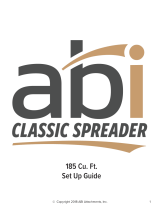
Setting components for use
All of the components on your TR3-E are adjustable using the compatible pins. By removing
these pins, you can adjust the components up and down within their respective pockets. The
profile blades, grooming rods, scarifiers, and leveling blade all have multiple adjustment
positions for fine tuned usage.
Renovation:
When you set up your TR3-E it is important to identify if the arena is in need of renovation first.
If you have significant highs and lows in your arena, or if it is compacted or has been neglected,
you may need to renovate prior to grooming. We recommend you hire a qualified professional to
renovate your arena. For the DIYers among us, please know renovation requires a different
setup from everyday grooming. The main objectives when renovating are to remove vegetation,
relieve compaction, and level out the arena. Please remember the arena did not get in bad
condition overnight. It will take time and a lot of effort to repair it, but you now own a tool that
can do the work!
Vegetation: Techniques used to eliminate vegetation from the arena will vary based on how
established the root system has become. For light recent vegetation, normal dragging should
eliminate the growth. To eliminate mature vegetation from the arena, if it is environmentally
responsible to do so, spray Roundup to kill the vegetation. Allow the arena to sit until the
vegetation dies (could be many days). Next, mow the vegetation as short as you are able and
use a blower and/or rake to remove the cut excess vegetation. Now use the TR3 E-Series
profile blades about an inch into the arena footing to slice the vegetation root system (like a sod
cutter). Do this when the arena is VERY dry. You will need to ensure that ALL other ground
engaging components are positioned up and out of play, otherwise they will plug up with
vegetation and begin to plow. Now that the vegetation is loose, it is time to collect it into spoils
piles for removal from the arena. Use the rear finish rake and leveling bar to collect vegetation
into spoils piles. The TR3 E-Series finish rake can be used to slowly
push vegetation backward
into the piles. Remove the piles and dispose of the vegetation with a front end loader or by
wheelbarrow from the arena.
Leveling & Loosening Arena Footing: The first thing you need to do is determine what the
"grade" of the arena is. “Grade” is the high point your arena footing material could reach on your
rail or wall, if all the footing material was evenly distributed consistently throughout the arena. In
many professionally installed arenas, this “Grade” point is actually marked somewhere on the
rail or wall. Perfect “grade” is a bit of a unicorn, as this is technically impossible to do without
laser guided hydraulic equipment, but for most people, getting close is good enough.
If you have a professionally installed base, gently dig down with a small shovel through the
hardpan footing until you reach the base material. The base is usually a different color from the
footing material and is much harder. Do this in about 20 areas throughout the arena in a grid
© Copyright 2017 ABI Attachments, Inc. 10

























